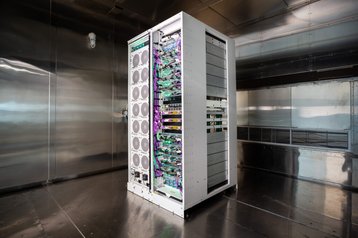Microsoft is pushing the envelope in data center efficiency with its latest innovations in cooling technology. The tech giant is adopting direct-to-chip liquid cooling and investigating the potential of microfluidics to enhance thermal management and minimize water usage.
In a recent blog post, Microsoft’s Corporate Vice President, Cloud Operations and Innovation, Noelle Walsh, detailed its ambitious plans to integrate direct-to-chip cooling in its data centers. The company is designing a new generation of data center infrastructure that utilizes cold plates for enhanced efficiency. This approach requires a complete redesign of server and rack layouts to incorporate advanced thermal and power management methods.
Microsoft’s current data centers are already benefiting from the company’s “sidekick” liquid cooling system, first introduced alongside its Cobalt CPU and Maia AI Accelerator chips last year. The Maia chips will be deployed in a custom rack and cluster system known as Ares. These Ares racks, which are notably wider than standard 19” or OCP racks, will be exclusively liquid-cooled, necessitating the use of water-to-air Condensing Units (CDUs) in some facilities.
The sidekick system features cooling infrastructure mounted on the side of the server units, circulating liquid to cold plates to manage heat effectively. Each Ares rack is equipped with eight servers, each housing four Maia accelerators.
Microsoft is also exploring microfluidic cooling technologies. Although still in the early stages of development, microfluidics involves embedding tiny fluid channels directly into chip designs. This method allows cooling fluids to be placed directly next to the processors, potentially improving cooling efficiency and precision.
Power and cooling are the two biggest challenges of data centers, given the scarcity of available public power and limited water resources. The bigger the compute, the greater the power requirements, and consequently, the more cooling is needed, which puts significant pressure on available resources. Data centers are coming under increased scrutiny for their depletion of these scarce resources, and many have attempted to address these concerns by implementing more sustainable practices. To counteract their environmental impact, data centers are increasingly investing in energy-efficient technologies, such as high-efficiency cooling systems, renewable energy sources, and intelligent power management strategies, to mitigate their environmental impact and ensure sustainability in an increasingly resource-constrained world.
While detailed information on Microsoft’s microfluidic research remains under wraps, the company emphasizes that these advancements are critical to its goal of becoming water-positive by 2030. In its 2023 Environmental, Social, and Governance (ESG) report, Microsoft reported water consumption of 6.4 million cubic meters in 2022, a figure that rose to 7.8 million cubic meters in 2023. This increase is attributed primarily to its expanding cloud data center operations.
To address its water consumption, Microsoft has ramped up its use of reclaimed and recycled water across various locations, including Texas, Washington, California, and Singapore. The company is also harvesting rainwater in the Netherlands, Ireland, and Sweden, with plans to extend this practice to new data centers in Canada, the UK, Finland, Italy, South Africa, and Austria.
Microsoft reports a significant reduction in water intensity, having cut its water consumption per kilowatt-hour by over 80% since the early 2000s. This achievement underscores the company’s commitment to sustainability and efficient resource management.
In addition to its direct-to-chip and microfluidic cooling innovations, Microsoft has explored other cooling technologies. The company previously partnered with immersion cooling firm Wiwynn to test two-phase immersion cooling solutions. The company also tested underwater data centers as part of its Project Natick, where it submerged 855 servers for over two years.
Microsoft’s ongoing advancements in cooling technologies reflect its broader strategy to enhance data center efficiency while minimizing environmental impact, aligning with its ambitious sustainability goals





